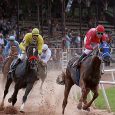Anyone who has attempted to profit from wagering on sporting events knows that in order to do so one must only wager when the known return exceeds the perceived risks. This is known as “value” betting. It sounds simple and the majority of literature on the subject seems to imply that value betting is only slightly more difficult than withdrawing money from an ATM machine.
Of course, if that were the case, the OTB parking lot would be packed with Corvettes and Ferraris rather than that rusted VW Rabbit with the duct tape trim that I always seem to spot when I visit my local establishment. The sad truth is the ability to detect value and bet accordingly is one of the most difficult aspects of successful wagering.
Contrary to what you may have heard, the sports betting crowd is one of the most well-informed, best-educated around. True, the Kentucky Derby infield would seem to argue against this, but ask your average regular bettor about their sport and most of them will be able to give you highly-detailed information and a persuasive rationale for betting. Compare that to the average person with a stock portfolio. During the market boom of the 1990s, many “investors” knew little more than the ticker symbols of the companies whose stocks they were so enthusiastically trading.
Frankly, finding overlays in sporting events is difficult precisely because there is so much information available to bettors. As a result, the sports betting markets tend to be fairly efficient. The fact that such-and-such pitcher is 7-1 against teams from the American League West when playing at night in a domed stadium is accounted for (and summarily dismissed if found to be irrelevant). Exclusive information is hard to come by and even harder to profit by, as it invariably has a very short lifespan.
So how does one find the elusive overlay? Well, not surprisingly, it takes a lot of time and a lot of record-keeping. You must begin by determining your rate of success at making a line. To do this, simply start rating your selections. In pari-mutuel events such as horse racing, it’s best to grade as many contenders as possible — but don’t feel compelled to rate every entrant. If you don’t know what rating to assign the first-time starter with the nondescript workouts, don’t bother. Consider the horse an “unknown” and move on. The idea is to find your acumen in events and on competitors that offer a basis for making an informed decision. Let’s face it, in some contests and/or for some people, no such basis exists.

(Photo via Hazel Park Raceway.)
How you rate each team or entrant is up to you. You can use a number, stars, check marks, etc. (once again, the greater the range of possible ratings the better). After this has been done, begin recording the results.
How do your best plays fare? At what odds do they typically win? How about your second choice, your third choice, the unknowns?
Keep your results as detailed as possible. The goal is to find out whether or not your plays are profitable, at what price, and under what conditions. To some, this may be discouraging as they may find that their selections aren’t profitable at any odds under any circumstances. If this is the case, don’t fret. It is better to learn such lessons on paper rather than in the unforgiving atmosphere of a racetrack or a sports book.
Use the information to become a better handicapper. Why are you losing? Set up hypothetical betting situations and track the results. Perhaps you are putting too much emphasis on starting pitchers, injuries, or the Beyer speed ratings. Ask yourself what rating you would assign if you ignored those factors. Whether you are winning or losing, you should always try to improve your play. You might be surprised at the strengths and weaknesses you can uncover by analyzing your performance in this manner.
One note of caution: try to refrain from drawing inferences on limited or irrelevant data. Inexperienced sports bettors are notorious for this. Just because a team is 8-0 ATS does not mean that you should be betting the mortgage payment. Statistically speaking, eight sample cases are practically meaningless as the basis for a definitive conclusion.
So too are most historical match-up records. The fact that a team is 14-3 all-time against today’s opponent is probably unimportant — rosters change, coaching staffs come and go, etc. Likewise, be cautious about angles or insights that you may unearth while scrutinizing facets of your own record. You should analyze at least 100 bets before tentatively accepting the results of any inquiry. I have learned (the hard way) what can happen when one wagers on mistaken “truths”.
Betting properly is hard. Betting for value is even harder and requires tremendous discipline. If you’re like me, you’re as much a fan of the sport(s) you’re betting on as you are a gambler and sometimes it’s hard to keep one’s love of a team or participant from intruding on the principles of sound wagering.
In a podcast I did before the 2004 Belmont Stakes, I advised all my listeners to bet against Smarty Jones because I knew he would be bet well below his fair odds (which I had tabbed at 1-1, or even). I offered my second choice Purge (at fair odds of 11-1) and my third choice Birdstone (at fair odds of 16-1) as the best alternatives. Yet, while I followed my own advice to some degree by betting both of them to win, all of my pick-3 and pick-6 tickets singled Smarty, because I so badly wanted to see a Triple Crown winner.
As a result, what should have been a huge day at the windows became a ho-hum day, even with a winning wager on Birdstone, who was 36-1. It is a mistake that most all of us will make from time to time and it is something that simply must be kept in check if one is to have any hope of triumphing over the bookies or the pari-mutuel machine.



